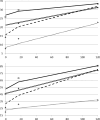Trajectories of Functional Change After Inpatient Rehabilitation for Traumatic Brain Injury
- PMID: 28392325
- PMCID: PMC5710828
- DOI: 10.1016/j.apmr.2017.03.009
Trajectories of Functional Change After Inpatient Rehabilitation for Traumatic Brain Injury
Abstract
Objective: To examine trajectories of functional recovery after rehabilitation for traumatic brain injury (TBI).
Design: Prospective study.
Setting: Inpatient rehabilitation hospitals in the Uniform Data System for Medical Rehabilitation.
Participants: A subset of individuals receiving inpatient rehabilitation services for TBI from 2002 to 2010 who also had postdischarge measurement of functional independence (N=16,583).
Interventions: Inpatient rehabilitation.
Main outcomes measures: Admission, discharge, and follow-up data were obtained from the Uniform Data System for Medical Rehabilitation. We used latent class mixture models to examine recovery trajectories for both cognitive and motor functioning as measured by the FIM instrument.
Results: Latent class models identified 3 trajectories (low, medium, high) for both cognitive and motor FIM subscales. Factors associated with membership in the low cognition trajectory group included younger age, male sex, racial/ethnic minority, Medicare or Medicaid (vs commercial or other insurance), comorbid conditions, and greater duration from injury date to rehabilitation admission date. Factors associated with membership in the low motor trajectory group included older age, racial/ethnic minority, Medicare or Medicaid coverage, comorbid conditions, open head injury, and greater duration to admission.
Conclusions: Standard approaches to assessing recovery patterns after TBI obscure differences between subgroups with trajectories that differ from the overall mean. Select demographic and clinical characteristics can help classify patients with TBI into distinct functional recovery trajectories, which can enhance both patient-centered care and quality improvement efforts.
Keywords: Recovery of function; Rehabilitation; Traumatic brain injury.
Copyright © 2017. Published by Elsevier Inc.
Figures
Similar articles
-
Regional Variations in Rehabilitation Outcomes of Adult Patients With Traumatic Brain Injury: A Uniform Data System for Medical Rehabilitation Investigation.Arch Phys Med Rehabil. 2021 Jan;102(1):68-75. doi: 10.1016/j.apmr.2020.07.011. Epub 2020 Aug 27. Arch Phys Med Rehabil. 2021. PMID: 32861669 Free PMC article.
-
Predictors of cognitive gains during inpatient rehabilitation for older adults with traumatic brain injury.PM R. 2023 Mar;15(3):265-277. doi: 10.1002/pmrj.12795. Epub 2022 May 5. PM R. 2023. PMID: 35233983 Free PMC article.
-
Cluster Analysis of Vulnerable Groups in Acute Traumatic Brain Injury Rehabilitation.Arch Phys Med Rehabil. 2018 Nov;99(11):2365-2369. doi: 10.1016/j.apmr.2017.11.016. Epub 2018 Jan 6. Arch Phys Med Rehabil. 2018. PMID: 29317223 Free PMC article.
-
Effectiveness of Neuropediatric Inpatient Rehabilitation.Neuropediatrics. 2024 Apr;55(2):83-89. doi: 10.1055/s-0043-1777124. Epub 2023 Dec 20. Neuropediatrics. 2024. PMID: 38122809 Review.
-
Medical-Legal Issues in Traumatic Brain Injury.Phys Med Rehabil Clin N Am. 2024 Aug;35(3):665-678. doi: 10.1016/j.pmr.2024.02.014. Epub 2024 Mar 21. Phys Med Rehabil Clin N Am. 2024. PMID: 38945658 Review.
Cited by
-
"Somewhere along the line, your mask isn't going to be fitting right": institutional racism in Black narratives of traumatic brain injury rehabilitation across the practice continuum.BMC Health Serv Res. 2024 Jul 24;24(1):834. doi: 10.1186/s12913-024-10986-1. BMC Health Serv Res. 2024. PMID: 39049041 Free PMC article.
-
Long-Term Change and Predictors of Change in Physical and Mental Function after Rehabilitation: A Multi-Centre Study.J Rehabil Med. 2023 Jan 5;55:jrm00358. doi: 10.2340/jrm.v55.2809. J Rehabil Med. 2023. PMID: 36601734 Free PMC article.
-
Integrated Care Pathways for Black Persons With Traumatic Brain Injury: A Critical Transdisciplinary Scoping Review of the Clinical Care Journey.Trauma Violence Abuse. 2023 Jul;24(3):1254-1281. doi: 10.1177/15248380211062221. Epub 2021 Dec 17. Trauma Violence Abuse. 2023. PMID: 34915772 Free PMC article.
-
Aging with Traumatic Brain Injury: Deleterious Effects of Injury Chronicity Are Most Pronounced in Later Life.J Neurotrauma. 2021 Oct 1;38(19):2706-2713. doi: 10.1089/neu.2021.0038. Epub 2021 Jul 20. J Neurotrauma. 2021. PMID: 34082606 Free PMC article.
-
Age Moderates the Effect of Injury Severity on Functional Trajectories in Traumatic Brain Injury: A Study Using the NIDILRR Traumatic Brain Injury Model Systems National Dataset.J Clin Med. 2022 Apr 28;11(9):2477. doi: 10.3390/jcm11092477. J Clin Med. 2022. PMID: 35566607 Free PMC article.
References
-
- Faul M, Xu L, Wald M, Coronado VG. Traumatic brain injury in the United States: emergency department visits, hospitalizations and deaths 2002–2006. Atlanta, GA: Centers for Disease Control and Prevention, National Center for Injury Prevention and Control; 2010. pp. 2–70.
-
- Langlois JA, Rutland-Brown W, Thomas KE. Traumatic brain injury in the United States: emergency department visits, hospitalizations, and deaths. Department of Health and Human Services, Centers for Disease Control and Prevention, National Center for Injury Prevention and Control; 2006.
-
- Dahdah MN, Barnes S, Buros A, Dubiel R, Dunklin C, Callender L, et al. Variations in Inpatient Rehabilitation Functional Outcomes Across Centers in the Traumatic Brain Injury Model Systems Study and the Influence of Demographics and Injury Severity on Patient Outcomes. Archives of Physical Medicine and Rehabilitation. 2016;97(11):1821–31. - PubMed
-
- Hart T, Kozlowski AJ, Whyte J, Poulsen I, Kristensen K, Nordenbo A, et al. Functional Recovery After Severe Traumatic Brain Injury: An Individual Growth Curve Approach. Archives of Physical Medicine and Rehabilitation. 2014;95(11):2103–10. - PubMed
-
- Whitlock JA, Jr, Hamilton BB. Functional outcome after rehabilitation for severe traumatic brain injury. Archives of Physical Medicine and Rehabilitation. 1995;76(12):1103–12. - PubMed
Publication types
MeSH terms
Grants and funding
LinkOut - more resources
Full Text Sources
Other Literature Sources
Medical


